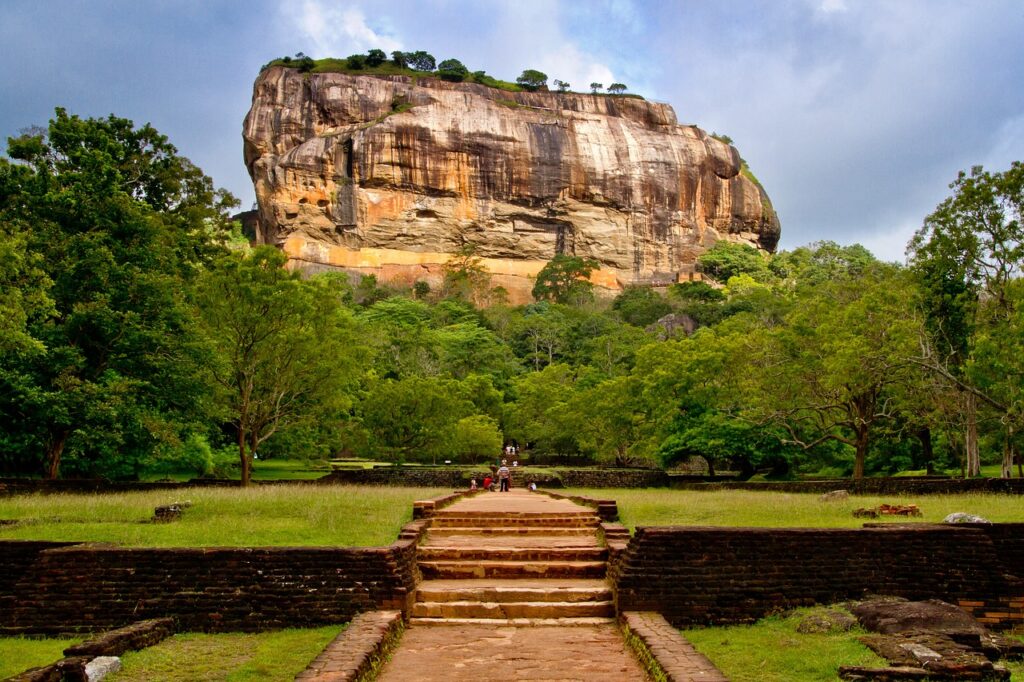“Sigiriya 8th Wonder and the pride of the Indian Ocean”
180 km from Colombo sits the rock fortress Sigiriya, which is a drive of about 3.5 to 4 hours. However, one would usually stop at Dambulla to look out for some interesting ancient historical places such as the caves and monasteries of the Buddhist monks.

History of Sigiriya
Sigiriya also known as Singhagiri or the Lion Rock as translated is located in the Matale District close to the town of Dambulla (A Place famous for the monasteries and historic Caves). The historic rock towers a height of 660 ft, in the epicentre of the cultural triangle (Kandy, Anuradhapura and Polonnauwa) and is known to be an ancient capital during the 5th Century AD. Today, Sigiriya is a UNESCO declared World Heritage Site.
Sigiriya also known as Singhagiri or the Lion Rock as translated is located in the Matale District close to the town of Dambulla (A Place famous for the monasteries and historic Caves). The historic rock towers a height of 660 ft, in the epicentre of the cultural triangle (Kandy, Anuradhapura and Polonnauwa) and is known to be an ancient capital during the 5th Century AD. Today, Sigiriya is a UNESCO declared World Heritage Site.
During the reign of King Kashyapa, this giant fortress a was built with a spectacle of beauty with in and around the vicinity, making it stand out as one of the most beautiful cities. The moat, pond, land scaping, the beautiful frescoes, and the mirror wall are just some of the specialties that add colour to this beautiful fortress. The Capital and fortress was seized after the demise of the King.
Landscape of the historic garden
The landscape and the gardens surrounding can be assumed to be one of the oldest and unique designs with plans that include water gardens, Rock garden and the terraced garden. The Moat that surrounds the complex was a defence mechanism of the time to safeguard the citadel and is said to have been filled with crocodiles. Further ahead is the Sigiriya Lake that provides water to the fortress. The path to the Rock passes through the garden.
The underlying water systems still remain a mystery due to the complex drainage system consisting of underground canals, Lakes, fountains, bridges as well as pumps. This engineering marvel demonstrates the knowledge in sophisticated constructions at the time of the ancient kings and to the amusement of all, until this day these waterways and pumps are still functional.
The Mirror Wall
 The mirror wall on the way to the entrance of the Rock palace above, used to be of a reflective nature due to the highly polished surface so much so that the king could see his reflections on the wall hence the name “Mirror Wall”. Further, it is also mentioned in books of history that the wall infront used to be filled with pictures of the damsels and during the sunset, the light would fall on the pictures causing a reflection of the light on the picture making it visible on the mirror wall. The wall now due to its wear and lack of maintenance does not reflect but is filled with graffiti and poems of love that dates to the 8th century.
The mirror wall on the way to the entrance of the Rock palace above, used to be of a reflective nature due to the highly polished surface so much so that the king could see his reflections on the wall hence the name “Mirror Wall”. Further, it is also mentioned in books of history that the wall infront used to be filled with pictures of the damsels and during the sunset, the light would fall on the pictures causing a reflection of the light on the picture making it visible on the mirror wall. The wall now due to its wear and lack of maintenance does not reflect but is filled with graffiti and poems of love that dates to the 8th century.
Frescoes of Damsels
 The frescoes of the ancient damsels painted on the walls of the rock were of flamboyant colours that date back to the 5th century. Most of the paintings were destroyed by those in the vicinity and the harsh weather conditions that leave the painting of about 18 from a gallery of almost 500 paintings. Currently, these frescoes are under the preservation of the government and has played a crucial role to conserve the frescoes. You will not be allowed to take pictures with the flash on since it can harm the paintings, therefore you will need to switch off your flashlights either on your cameras or mobile devices.
The frescoes of the ancient damsels painted on the walls of the rock were of flamboyant colours that date back to the 5th century. Most of the paintings were destroyed by those in the vicinity and the harsh weather conditions that leave the painting of about 18 from a gallery of almost 500 paintings. Currently, these frescoes are under the preservation of the government and has played a crucial role to conserve the frescoes. You will not be allowed to take pictures with the flash on since it can harm the paintings, therefore you will need to switch off your flashlights either on your cameras or mobile devices.
Lion Entrance and Breath taking view
 The climb up to the lion’s entrance can be tiring, so one could rest at this point in the open area. The Lion entrance used to have the face of a lion through which the king would enter, however, the remains of the 2 paws of the lion is the only evident structure of the lion.
The climb up to the lion’s entrance can be tiring, so one could rest at this point in the open area. The Lion entrance used to have the face of a lion through which the king would enter, however, the remains of the 2 paws of the lion is the only evident structure of the lion.
On climbing on to the top of the rock, one would be able to see the remnants of the palace (mostly the foundations) and clearly a well fortified fortress. One of the most amazing architectural marvels is the pond on top of the rock.on reaching the peak one would be able to see the most astounding and breath taking view of the entire Mass of land in the vicinity with a clear view of the landscape, forests, lakes and the touch of the age old breeze.
To reach the top of the rock, it can take up to 1 hour but the feeling of reaching the peak is an adrenaline booster and the breath-taking view from the top is just an invaluable and impeccable sight of magnificence.
Timings to visit
The best time to visit the place would be the mornings, as by day time, it can get warm and humid, thus tiring. This place does not like to rush, but relax and enjoy nature thus earlier the better.
Keep in mind!!
- Have a bottle of water and some food as well for yourself and keep yourself hydrated
- On your way up u may find moneys so please be mindful of your belongings
- Please do not litter the place and destroy the prestinity
- You may have to pay about USD 30 as an entrance fee.
- Grab your cameras and camcorders to capture the moments
- Switch off the flashlights on capturing the frescoes
- Avoid visiting on rainy days as it can get slippery
- Lastly don’t forget to enjoy your journey.


